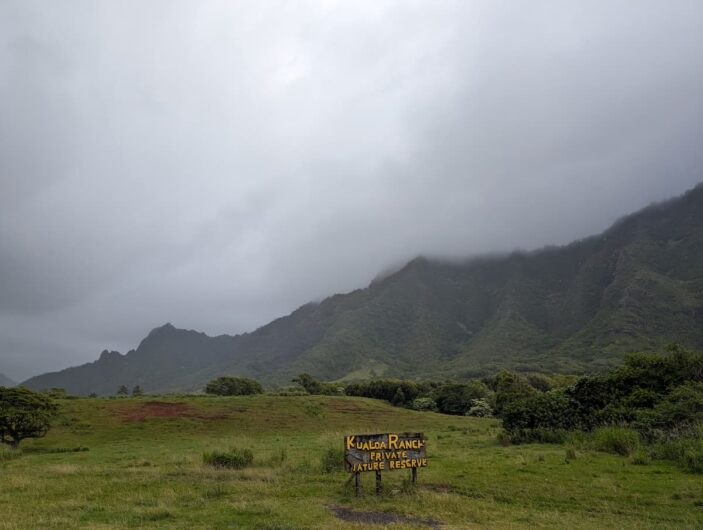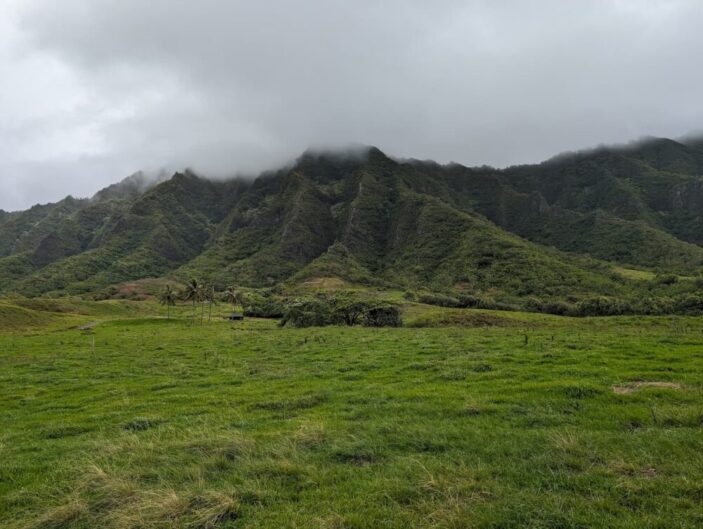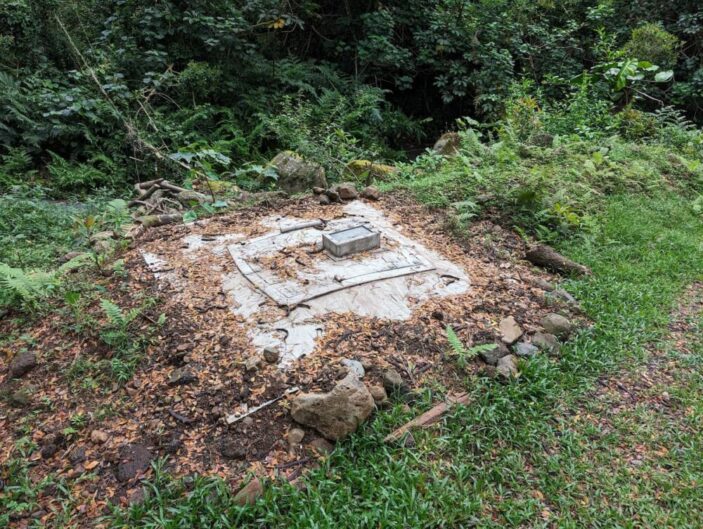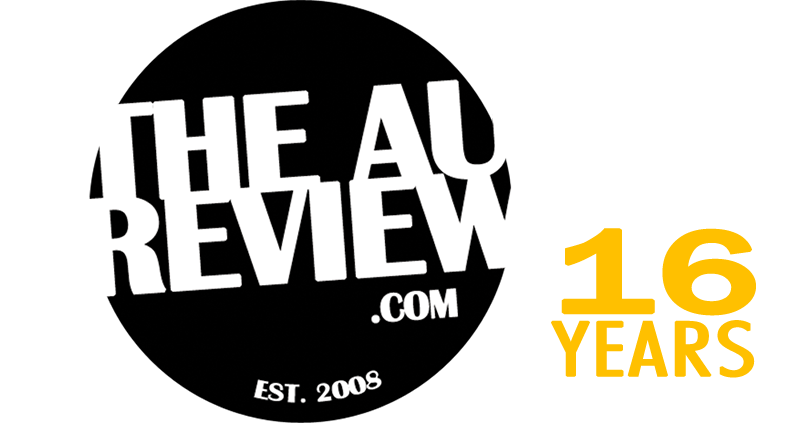
I’ve traced O’ahu to the island’s bucolic north-east and find myself in the heart of a 4,000-acre private nature reserve. Kualoa Ranch has been a filming location for more than 250 movies and TV shows, so even those who’ve never been before have some level of familiarity with the blockbuster landscape.
Jurassic Park, LOST, Hawaii Five-0, King Kong, Jumanji, 50 First Dates. That’s not all. Mighty Joe Young, George of the Jungle, Windtalkers, Magnum P.I, Pearl Harbor…the music video for Nicki Minaj’s “Starships”. All of them have benefited from this wonderfully preserved, wide open ranch, which feels appropriately torn from the touristy chaos of Waikiki.
There’s not a Five Guys in sight and I can hardly believe I’m on the same island as all those open-air designer malls.
Instead, I’m staring at spectacular granite cliffs feathered with snaking greenery, the blanket of green and grey occasionally bumping over sightly fish ponds. The working ranch is bountiful for the islands. but most tourists would know it as Hollywood’s Hawaii backlot: the genesis of this emerging trend that label-happy travel folk have cleverly dubbed “set-jetting.”
It’s not hard to understand. The trend has been around for decades but it’s only now being polished as a bonafide tourism-driver thanks to HBO’s The White Lotus and the wonder it’s done for luxury hotels in Italy and Thailand.
That pop culture can serve as travel inspiration is no surprise. Timeless properties like Jurassic Park and The Lord of the Rings come with a huge degree of emotional connection. To characters, to style, to music. And whatever builds an abstract bridge to fans also plants certain scenes in their head.
There’s a unique value in that. When you read a book, and then watch its filmic counterpart, you’re met with a kind of cognitive dissonance between how you envisioned the story and someone else’s visual interpretation. It almost never aligns, and inevitable disappointment sets in.

There’s a similar cognitive process here. You’ve watched those films or shows and fallen in love with the sets. You’ve fallen in love with the characters that live on those sets. You’ve fallen in love with the story framed by those sets.
And so when you see something that’s been shot-on-location, and you eventually experience that location for yourself, it registers and resonates differently. If you’re a life-long Jurassic Park obsessive, for example, seeing the deep valleys of Kualoa Ranch gives life to a familiarity that’s been buried in your subconscious.
I think that’s why New York City has such a profound effect on first timers. Most travellers would have grown up with these wondrous skyscrapers, whether that means Manhattan that’s been dressed in retro austerity (a la Mad Men), the beats of contemporary chaos (Succession) or the childlike wonder of getting lost in this unforgiving concrete jungle (Home Alone 2). There’s a mental map of New York City that lies dormant inside of every pop culture-obsessive, springing to life as soon as you hop in a Yellow Cab and zip along the deafening streets of Midtown.
It’s a fun process to observe in a real-time, stepping onto your favourite sets and watching as your imagination starts to draw parallels. That attention you’ve lovingly given the big and small screens for so long is finally drawn away from the screen and into the present. And if the wellness trend has taught us anything, it’s that presence is the cut-off between a memorable holiday and a stressful one.

Lost & Found
With the exception a few city scenes shot across London, Los Angeles and Sydney, J.J. Abrams’ LOST was shot almost exclusively on O’ahu. And the many fans who still obsess about the show decades later should be intimately familiar with the majesty of Kualoa Ranch.
There is a ridiculous number of tours you can take on the ranch. It’s a heavily touristed powerhouse, but even the swarms of curious visitors hoping to take in as much of the ranch as possible seems like nothing compared to the natural beauty.
These cliffs drawf us as we scurry around the visitor’s centre, which is heavily signposted to direct these crowds of people towards their designated tour.
There are large UTVs for the famously comprehensive UTV Raptor tour, where a single file of these utility terrain vehicles rolls deep into the rainforest and pops up smaller, more intimate filming locations. There’s the stable with dozens of horses for those wanting to saddle up and strut the valley. There are shuttle buses for the more stock-standard tours. And then there’s a bunch of other activities like zip lining and stand-up paddleboarding at the nearby Secret Island Beach.
If I had more time, and was travelling without my mother, I would have jumped right onto one of those UTVs. Instead, it was onto a bus for me, trailing through the more approachable Movie Sites Tour which (around $US60) took had us snaking through Jurassic Valley with our guide pointing out the obvious scenery.
Everyone has different reactions, because everyone has come to this place with a different context. There’s the Jurassic Park fanatic behind me that can’t stop grinning once we get to Ka’a’awa valley. Our tour guide points out the log (not the exact one) that Alan Grant, Time and Lex hid behind when they were being chased by a herd of Gallimumus in the first Jurassic Park film. It’s the same hill where Hurley built a makeshift golf course in those middle episodes of Lost’s third season when the writers’ strike was most obvious.
I’m thinking of Hurley, Jin and Sawyer hurtling down a hill in a Scooby Doo-esque Volkswagen. She’s thinking of a swarm of dinosaurs heading right for us. We’ve both been arrested by that ever-loving process that made set-jetting such a fun travel trend.

Is Set-Jetting always a good thing?
Anything that gets people travelling around the world, supporting local businesses, meeting new people, find themselves, soul-searching, forming life-affirming memories, learning about new cultures, building their scope of what being human is, seeing history up close, understanding themselves and the world around them, and finding new hobbies. Anything that encourages that is always going to be a force for good.
But media isn’t always good for travel. In fact, there are many times when media has completely betrayed travel and misrepresented places, only to play with people’s expectations and potentially set them up – and a given destination – for failure.
Paris is a great example of this. The big city is an urban centre like any other, but it’s famously idealised as the world’s most romantic city. And yes, it’s great. I’ve been once, when I was 9, but I do know how what a stunning place it can be. Some of the most reprehensible people I know say Paris is their favourite city, as well.
Aside from a handful of travel-to-brag socialites, almost everyone I’ve met say Paris is one of the most overrated places they’ve ever been to. Fair? Maybe. Doubt it. It’s impossible to imagine a big city that’s been absolutely plastered in French culture could ever be boring. But I understand the disappointment.
Pop culture gives us unfair expectations of what a city could be, because they often present the idealised versions. Paris has been written large in many classic shows, and it’s almost always portrayed as this large, sprawling city where love lives. But Paris is oft considered just as chaotic as New York and annoyingly pretentious as Los Angeles.
I doubt anyone who has been walks away hating, the city, but feelings are intensified and interpreted as a function of prior expectations. If you are even slightly disappointed, you’ll feel more negative about the city than you would have had you not had those expectations. Pop culture isn’t always a travel destination’s friend.
The best places to jet-set
City-based movies aren’t as potent for this trend. Succession doesn’t make New York City look cool, it makes New York City look annoying. Instead, the best screen-destination combinations almost always lie in how unrealistic it all is.
The Lord of the Rings was the most effective tourism campaign New Zealand could have asked for. The most memorable sets from Mission Impossible and James Bond movies always take place outdoors with big, chunky action sequences in destinations like Kashmir and Matera. It’s those big scenes that inspire wonder which are friendliest for tourist destinations.
Us humans have an obsession with things that are both bigger and smaller than us. We tend to ignore anything that’s of a similar size and stature. Those who think big tend to be drawn to these pop culture travelogues, even if they don’t like the story. Because they know that once they visit, they’ll be writing their own.
The author explored O’ahu as a guest of Go Hawaii.
